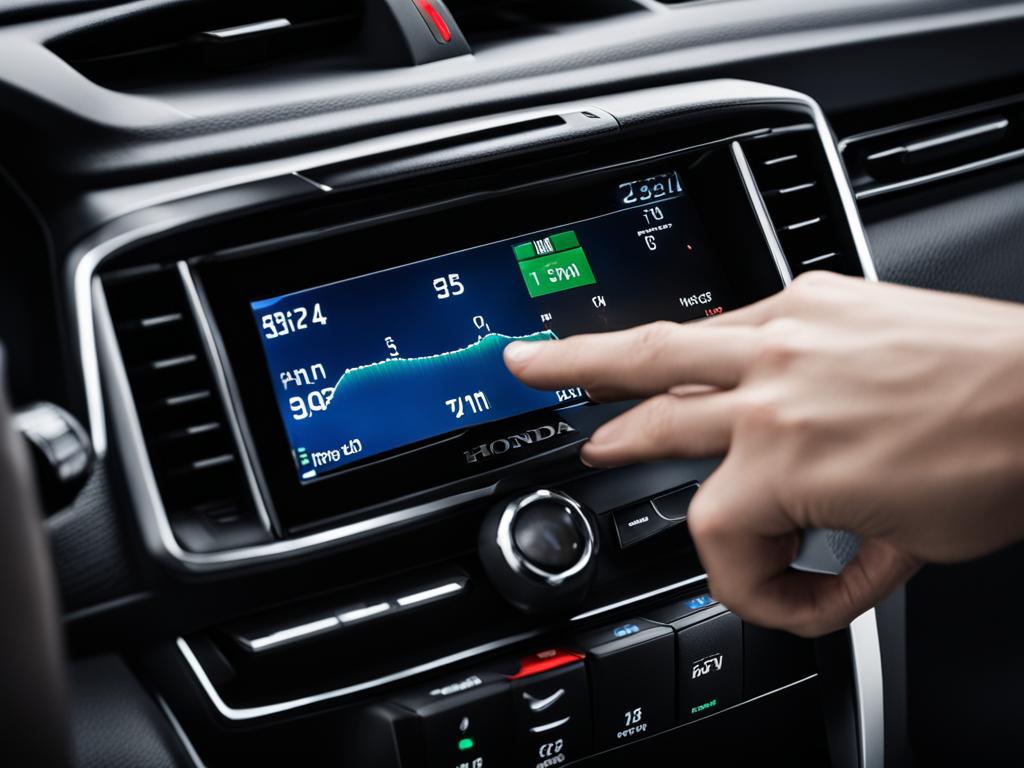Reset Tire Pressure Light on Honda CRV – Quick Guide
Is your Honda CRV’s tire pressure light on? Don’t worry, resetting it is easier than you think. By following a simple calibration process, you can ensure that your tire pressure monitoring system (TPMS) accurately detects any changes in your tire pressure. In this quick guide, we’ll walk you through the steps to reset the tire pressure light on your Honda CRV, ensuring optimal tire performance, fuel efficiency, and driving safety.
Key Takeaways:
- Resetting the tire pressure light on your Honda CRV is essential after any changes to your tires.
- Consult your owner’s manual or visit the Honda website for specific instructions for your Honda CRV model.
- For newer models with a touchscreen display, go to the settings menu, select vehicle, choose TPMS Calibration, and then select calibrate.
- For older models with steering wheel buttons, press the menu button, select customize settings, choose TPMS Calibration, and select initialize.
- If the TPMS warning light continues to flash even after calibration, visit a Honda service center for assistance.
Understanding the Tire Pressure Monitoring System (TPMS)
The TPMS is a vital component of your Honda CRV that continuously monitors the air pressure in your tires. It alerts you when the tire pressure is low, ensuring optimal tire performance, fuel efficiency, and driving safety. The TPMS automatically triggers a warning light on your dashboard, commonly referred to as the tire pressure light, when it detects that one or more tires have low pressure. It’s important to note that the TPMS is not a substitute for regularly checking your tire pressure with a gauge.
When the tire pressure light illuminates, it’s crucial to address the problem promptly and reset the system. Failure to maintain proper tire pressure can lead to tire damage, reduced handling and control, decreased fuel efficiency, and potential safety hazards. By resetting the TPMS, you ensure that it accurately monitors your tire pressure and provides you with timely warnings.
Why is TPMS important?
The TPMS is an essential feature in modern vehicles, including the Honda CRV. It plays a crucial role in maintaining optimal tire performance, fuel efficiency, and driving safety. Here are a few key reasons why the TPMS is important:
- Proactive tire pressure monitoring: The TPMS continuously monitors your tire pressure, enabling you to address any issues promptly before they escalate. This proactive approach helps prevent potential tire damage and accidents caused by low tire pressure.
- Optimal tire performance: Proper tire pressure ensures even tread wear and optimal grip on the road. This improves handling, stability, and overall tire performance, enhancing your driving experience and safety.
- Fuel efficiency: Underinflated tires increase rolling resistance, causing your vehicle to consume more fuel. By maintaining proper tire pressure, you maximize fuel efficiency, saving money and reducing your carbon footprint.
- Increased safety: Well-inflated tires provide better traction, especially in adverse weather conditions. This enhances braking performance and vehicle stability, reducing the risk of accidents.
Addressing low tire pressure
When the tire pressure light illuminates on your Honda CRV, it’s essential to address the issue promptly. Ignoring low tire pressure can lead to further complications and safety risks. Here are the steps you can take to address low tire pressure:
- Manually check tire pressure: Use a reliable tire pressure gauge to check the pressure in each tire. Compare the readings to the recommended tire pressure specified in your vehicle’s owner’s manual.
- Inflate tires as needed: If any tire has low pressure, inflate it to the recommended level. Use an air compressor or visit a nearby gas station with an air pump.
- Reset the TPMS: To ensure accurate monitoring, reset the TPMS system on your Honda CRV. This can be done using the appropriate method for your specific model, as outlined in the owner’s manual.
- Monitor tire pressure regularly: Make it a habit to check your tire pressure at least once a month and before long trips. Regular maintenance will help you identify any issues early on and prevent potential problems.
Remember, maintaining proper tire pressure is essential for the longevity of your tires, fuel efficiency, and driving safety. By understanding and utilizing the TPMS feature on your Honda CRV, you can ensure a smooth and secure driving experience.
Resetting TPMS on Your Honda CRV – Step-by-Step Instructions
Resetting the TPMS on your Honda CRV is a straightforward process that requires a few simple steps. First, it’s important to locate the TPMS reset button, which can vary in location depending on the model year of your Honda CRV. Consult your owner’s manual to find the exact location.
Once you have found the reset button, ensure that your vehicle is stationary with the ignition off and all doors closed. Switch the ignition key to the “on” position without starting the engine.
Press and hold the TPMS reset button for approximately 10 seconds. During this time, observe the behavior of the tire pressure light. You may notice the light blinking or turning off completely. Continue holding the button until the light stops blinking or remains off.
After successfully resetting the TPMS, turn on your Honda CRV and take a short drive. The system needs some time to recalibrate and register the tire pressures.
If the tire pressure light continues to appear even after resetting, it’s advisable to manually check the tire pressure using a reliable gauge and adjust as necessary.

Importance of Proper Tire Pressure and TPMS Maintenance
Maintaining proper tire pressure is crucial for several reasons. Firstly, it ensures optimal tire performance and longevity. Underinflated or overinflated tires can lead to uneven wear patterns, reduced traction, and compromised handling and braking capabilities. Secondly, proper tire pressure contributes to fuel efficiency. When tires are properly inflated, the rolling resistance is minimized, resulting in better fuel economy.
Furthermore, maintaining the correct tire pressure is essential for driving safety. Underinflated tires can overheat and potentially fail, leading to tire blowouts and accidents. On the other hand, overinflated tires can cause a harsher ride, reduced stability, and increased vulnerability to damage from road hazards.
The TPMS plays a crucial role in ensuring that you are promptly notified of any deviations from the recommended tire pressure. By resetting the TPMS on your Honda CRV and regularly checking your tire pressure, you can ensure a smooth and safe driving experience.
Proper tire pressure maintenance not only improves safety but also enhances your driving comfort and extends the lifespan of your tires. By following the recommended tire pressure guidelines provided by Honda and regularly monitoring your tire pressure with the help of the TPMS, you can mitigate potential risks and ensure optimal performance on the road. Remember, a well-maintained tire pressure system leads to a smoother, more fuel-efficient, and safer driving experience.
Conclusion
Resetting the tire pressure light on your Honda CRV is a simple process that you can easily do at home. By following the step-by-step instructions and regularly monitoring your tire pressure, you can ensure optimal tire performance, fuel efficiency, and driving safety.
Remember to consult your owner’s manual or visit the Honda website for model-specific instructions, as the reset methods may vary depending on the model year of your Honda CRV. It’s important to stay informed and follow the recommended procedures.
If you encounter persistent issues with the TPMS or have concerns about your tire pressure, it’s highly recommended to visit a Honda service center for expert assistance. They have the necessary knowledge and equipment to diagnose and resolve any problems you may be experiencing.
Proper tire pressure and TPMS maintenance are essential for a smooth, safe, and efficient driving experience with your Honda CRV. By taking the time to reset the tire pressure light and regularly checking and adjusting your tire pressure as needed, you can confidently enjoy your journeys with peace of mind.
FAQ
How do I reset the tire pressure light on my Honda CRV?
To reset the tire pressure light on your Honda CRV, you need to perform a simple calibration process. This is necessary after any changes to your tires such as reinflation, tire rotation, or tire replacement. The calibration process typically takes about 30 minutes of driving between 30-65 miles per hour. There are different methods for resetting the TPMS light in newer and older Honda CRV models. For newer models with a touchscreen display, you can go to the settings menu, select vehicle, choose TPMS Calibration, and then select calibrate. In older models with steering wheel buttons, you can press the menu button, select customize settings, choose TPMS Calibration, and select initialize. Some older models may also have a dedicated TPMS button that needs to be pressed and held. It’s important to consult your owner’s manual or visit the Honda website for specific instructions for your particular Honda CRV model. If the TPMS warning light continues to flash even after calibration, it indicates a malfunction in the system and you should visit a Honda service center to resolve the issue.
What is the Tire Pressure Monitoring System (TPMS) in a Honda CRV?
The TPMS is a vital component of your Honda CRV that continuously monitors the air pressure in your tires. It alerts you when the tire pressure is low, ensuring optimal tire performance, fuel efficiency, and driving safety. The TPMS automatically triggers a warning light on your dashboard, commonly referred to as the tire pressure light, when it detects that one or more tires have low pressure. It’s important to note that the TPMS is not a substitute for regularly checking your tire pressure with a gauge. When the tire pressure light illuminates, it’s crucial to address the problem promptly and reset the system. Failure to maintain proper tire pressure can lead to tire damage, reduced handling and control, decreased fuel efficiency, and potential safety hazards. By resetting the TPMS, you ensure that it accurately monitors your tire pressure and provides you with timely warnings.
How do I reset the TPMS on my Honda CRV?
Resetting the TPMS on your Honda CRV is a straightforward process that requires a few simple steps. First, it’s important to locate the TPMS reset button, which can vary in location depending on the model year of your Honda CRV. Consult your owner’s manual to find the exact location. Once you have found the reset button, ensure that your vehicle is stationary with the ignition off and all doors closed. Switch the ignition key to the “on” position without starting the engine. Press and hold the TPMS reset button for approximately 10 seconds. During this time, observe the behavior of the tire pressure light. You may notice the light blinking or turning off completely. Continue holding the button until the light stops blinking or remains off. After successfully resetting the TPMS, turn on your Honda CRV and take a short drive. The system needs some time to recalibrate and register the tire pressures. If the tire pressure light continues to appear even after resetting, it’s advisable to manually check the tire pressure using a reliable gauge and adjust as necessary.
Why is proper tire pressure important for my Honda CRV?
Maintaining proper tire pressure is crucial for several reasons. Firstly, it ensures optimal tire performance and longevity. Underinflated or overinflated tires can lead to uneven wear patterns, reduced traction, and compromised handling and braking capabilities. Secondly, proper tire pressure contributes to fuel efficiency. When tires are properly inflated, the rolling resistance is minimized, resulting in better fuel economy. Furthermore, maintaining the correct tire pressure is essential for driving safety. Underinflated tires can overheat and potentially fail, leading to tire blowouts and accidents. On the other hand, overinflated tires can cause a harsher ride, reduced stability, and increased vulnerability to damage from road hazards. The TPMS plays a crucial role in ensuring that you are promptly notified of any deviations from the recommended tire pressure. By resetting the TPMS on your Honda CRV and regularly checking your tire pressure, you can ensure a smooth and safe driving experience.
Can I reset the tire pressure light on my Honda CRV myself?
Yes, resetting the tire pressure light on your Honda CRV is a simple process that can be done at home. By following the step-by-step instructions and regularly monitoring your tire pressure, you can maintain optimal tire performance, fuel efficiency, and driving safety. Remember to consult your owner’s manual or visit the Honda website for model-specific instructions, as the reset methods may vary depending on the model year of your Honda CRV. If you encounter persistent issues with the TPMS or have concerns about your tire pressure, it’s recommended to visit a Honda service center for expert assistance. Proper tire pressure and TPMS maintenance are essential for a smooth, safe, and efficient driving experience with your Honda CRV.




